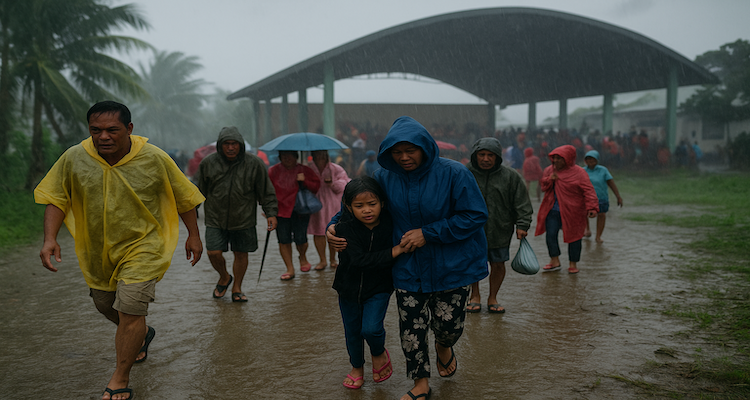Super Typhoon Fung-Wong Slams Philippines, Forces Mass Evacuations
Super Typhoon Fung-Wong batters the Philippines with deadly winds and torrential rain, killing two and forcing over a million residents to evacuate as Luzon braces for landfall.
A Nation on Edge as Fung-Wong Tears Through the Philippines
The Philippines is once again at the mercy of nature’s fury as Super Typhoon Fung-Wong, locally named Uwan, barrels through central and eastern regions, bringing destructive winds and relentless rains. At least two people have been reported dead, while more than a million residents fled their homes in anticipation of the storm’s full impact on northern Luzon.
Electricity has been cut across wide areas of the Bicol region as the typhoon packing sustained winds of 185 km/h (115 mph) and gusts reaching 230 km/h (140 mph) continues to unleash chaos before its expected landfall in Aurora province by Sunday night.
Mass Evacuations and Rising Warnings
Authorities have placed most of Luzon, the country’s largest and most populated island, under the highest storm warning levels, with Metro Manila and surrounding provinces on alert level 3. The civil aviation authority has shut down several key airports, including Bicol International Airport and Sangley Point Airport in Metro Manila, as a precaution.
The Civil Defense Office confirmed two fatalities: one victim drowned in Catanduanes, while another woman was found beneath the wreckage of a collapsed home in Catbalogan City.
Defense officials emphasized that the country is on high alert as the massive storm system moves northward, threatening to overwhelm disaster response units still stretched thin from Typhoon Kalmaegi, which recently claimed 224 lives in the Philippines and five in Vietnam.
Fung-Wong’s Path and Forecast
According to the Philippine Atmospheric, Geophysical, and Astronomical Services Administration (PAGASA), Fung-Wong will maintain typhoon strength as it tracks northwest on Monday and north by Tuesday. By Wednesday, it is expected to reach the Taiwan Strait, weakening slightly before making landfall in western Taiwan on Thursday. Meteorologists project that the system will lose strength rapidly afterward, dissipating into a weaker tropical disturbance near Japan’s Ryukyu Islands.
Authorities Urge Compliance: “Evacuate Before It’s Too Late”
In a nationwide address, Defense Secretary Gilberto Teodoro pleaded with residents to heed evacuation orders.
“We ask that people evacuate preemptively so we don’t have to conduct rescues at the last minute,” he said. “Rescue operations in these conditions put the lives of police, soldiers, firefighters, and coast guard personnel at risk.”
Officials stressed that ignoring evacuation directives is not only dangerous but also unlawful under national disaster protocols.
To bolster readiness, the Philippine military has reassigned 2,000 troops from training operations to humanitarian and rescue efforts in typhoon-hit areas.
Scenes of Fear and Resilience
In Isabela province, dozens of families have sought refuge in a basketball court turned evacuation center. Among them is Christopher Sanchez, a 50-year-old resident who evacuated early with his children and grandchildren.
“We heard the storm would be very strong, so we left early,” Sanchez said. “Every time there’s a storm, we come here because we live by the river. Last time, the floodwaters rose above our heads. We’re scared, but we’re safe together.”
His words echo the anxiety felt across Luzon as communities brace for possible flash floods, landslides, and widespread destruction.
A Season of Relentless Storms
Fung-Wong marks the 21st tropical cyclone to hit the Philippines this year surpassing the nation’s annual average of 20. Its arrival comes just weeks after Typhoon Kalmaegi devastated large parts of the country, compounding the strain on relief efforts and testing the limits of the country’s disaster preparedness systems.
Experts warn that climate change may be intensifying these tropical systems, making storms stronger and recovery efforts more difficult. The Philippines, located in the western Pacific “typhoon belt,” remains one of the world’s most disaster-prone countries.
Government Response and Humanitarian Outlook
Relief agencies are coordinating with local governments to distribute emergency food, water, and medical supplies. Shelters across northern Luzon are being readied for additional evacuees, while the Department of Social Welfare and Development (DSWD) is on standby to assist affected families.
Despite preparations, officials fear that prolonged rainfall could lead to major flooding and landslides in mountainous areas, posing risks to communities that have yet to recover from previous disasters.
Looking Ahead
Meteorologists anticipate that once Fung-Wong moves toward Taiwan and the Ryukyu Islands, it will gradually weaken but its effects on the Philippines could linger for days, especially through widespread flooding and disrupted livelihoods.
For now, the nation waits. Families huddle in evacuation centers, farmers brace for crop losses, and rescuers stand ready, hoping the worst of the storm will pass without adding to the growing toll of tragedy.
(Disclaimer: This article is based on verified information from official Philippine government sources and reputable weather agencies.)
ALSO READ: Trump Pulls U.S. Out of South Africa G20 Over ‘Human Rights Abuses’










